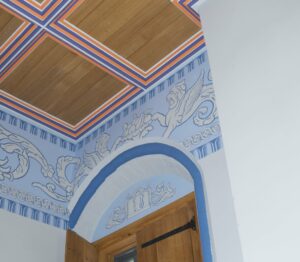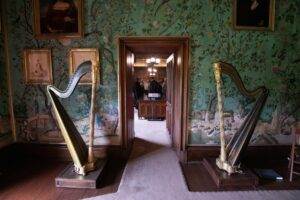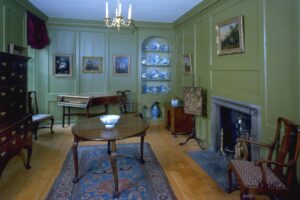How to get an authentic look with traditional interior paint and finishes
Homeowners, Maintenance | Written by: Katie Sludden | Friday 17 November 2023
Does a room in your traditional home (built pre-1919) need a fresh coat of paint? Or are you researching a traditional look for your interiors? Learn about traditional interior paint finishes, why you should use them, and get inspired with some fine examples from across Scotland.
There’s an abundance of heritage paint options on the market and a traditional look is a popular trend. What better way to achieve it than with traditional interior paint finishes?

The restored dining room at Duff House, Aberdeenshire.
Why use traditional finishes?
If you’re interested in going for a more authentic or traditional look, think about the benefits of using a traditional finish. In comparison to modern paints and finishes, current options for traditional coatings are:
- Less environmentally harmful and safer for people to use, if they’re water-based and solvent-free. To learn more, read the British Coatings Federation’s guide on Volatile Organic Compounds (VOCs) in coatings.
- Visually appealing with a finish that is more appropriate to the character of a building’s interior. Impactful, with shading and depth of colour offering subtly changing hues in different light conditions. This is because they contain a variety of pigments, each with differing properties in terms of size, shape and reflectivity.
- Breathable, meaning they absorb moisture and allow it to disperse freely. In areas of damp and after the cause of dampness has been resolved, applying a porous coating can allow the wall to dry.
It’s wise to remember that older or original coatings may also contain lead. All modern paints, even traditional paints and finishes are now lead-free, in compliance with EU legislation. To help you identify lead paint, here’s the Department of Environment, Food and Rural Affairs’ (DEFRA) leaflet: Look out for lead paint in your home.

Decorative paint scheme, part of the restoration works at Stirling Palace in 2010.
An early Scottish interior decorator
One of the earliest writings on how colours influence a space is from mid-19th century Scottish interior decorator and author David Ramsay Hay. Hay decorated Abbotsford, the home of Sir Walter Scott, the Palace of Holyroodhouse for Queen Victoria, and the National Gallery of Scotland. He published some of the earliest writings on colour theory, including the The Laws of Harmonious Colouring Adapted to Interior Decorations stating that “as harmonious music delights and refines the mind through the ear, so does harmonious colouring act as an agent of civilisation, in delighting and refining the mind through the visual organ”.

The Chinese Drawing Room, Abbotsford House, Melrose.
Early colour schemes
Historically nearly all domestic interiors had some form of painted surface finish, but before the Victorian era, the types of coating available were limited in terms of texture, finish and available colours.
It was only in the 18th century where we find examples for more standard practices for interior painting and finishes. This was a period when many people migrated from rural settings to urban dwellings, such as tenements.

The entrance hall of Blairtummock House, Glasgow, in 2008 after its restoration. © Simpson and Brown Architects. Licensor SCRAN.
Tenement common stair walls
It’s best to consult all the owners before starting a project for common stair walls as these would be a shared (or common) repair. These are not strictly an interior feature but it’s useful to know a bit about typical traditional tenement colour schemes.
Common stair walls followed a standard look, usually with two colours split by a dado line. This means that there would be a lower band of gloss paint (to give protection and durability) and an upper matt painted area. This upper area would have originally been painted with distemper but is now usually painted with matt emulsion. The dado line can have an ornamental beading and would be around five feet (1.53m) high, above the steps of the stairs.

Painted tenement stair walls, Glasgow (built c.1880).
Rooms had different colour schemes
In the early 18th century, some colours were more expensive than others due to the cost of ingredients. Later advances in synthetic dye production allowed for bold, bright colours previously only affordable for high-status buildings (hence names such as Royal Blue or Imperial Purple).
Different parts of a house sometimes had specific colour schemes. Larders and store cupboards were often painted dark blue (thought to discourage flies), and dining rooms were dark green.
Facings and finishes in service areas were painted in darker reds and browns, probably due to the lower costs of the pigment. This distinguished them from the lighter-coloured or varnished timber surfaces in the main rooms.
Today, many designers place colder neutral hues in entrance spaces and hallways and then introduce warmer tones as you move into living areas.

Earthy hues in this restored kitchen at the House of Dun, Montrose, Angus. © National Trust for Scotland. Licensor SCRAN.
Can you follow historic paint schemes?
You might find evidence of original paint schemes if there are surviving layers. These will tell you how the space was originally decorated. If you’re seeking a precise match to the original colour schemes on plaster and woodwork, specialist conservators can undertake a paint analysis for you. This will identify the various layers of paint, their composition and likely age, allowing a closer match to be made.
Care should be taken when removing paint as some older layers may be from lead paints. Consider engaging an experienced contractor for these kinds of specialist restoration projects. Find out more with our links below.

Gladstone’s Land, Edinburgh. This room is decorated in the Georgian style with its walls panelled with wainscot (panelling). © Edinburgh College of Art. Licensor SCRAN.
Do you have painted timbers in your property? Want to learn more about traditional interior paint and finishes? Or do you need some practical advice on its maintenance and application? Read our blog on Top tips for using and maintaining traditional interior paint and finishes.
Want to find out more about Scotland’s shifting social history through interiors? Explore six great Scottish interiors with our online exhibition.
Watch this inspiring film about decorative paintings at Law’s Close, Kirkcaldy.
Need more information on choosing the right paint finish for the job? This blog has been abridged from our Inform Guide: Interior Paint: A Guide to Interior Paint Finishes prepared and written by Roger Curtis.
You can find examples of traditional interiors throughout our properties, from discreet ones to the most prized and decorated. Many can be seen in our image collections online:
Our free downloadable guides and our website have guidance to help owners of traditional buildings:
- Share this:
- Share this page on Facebook
- Share on X
About the author:
Katie Sludden
Katie Sludden is a Technical Content Officer, working at the Engine Shed as part of the Technical Education and Training team. Her background is in Archaeology and Fine Art, with recent experience in Conservation Area Regeneration. She loves to develop engaging, inspiring and educational content.
View all posts by Katie Sludden



